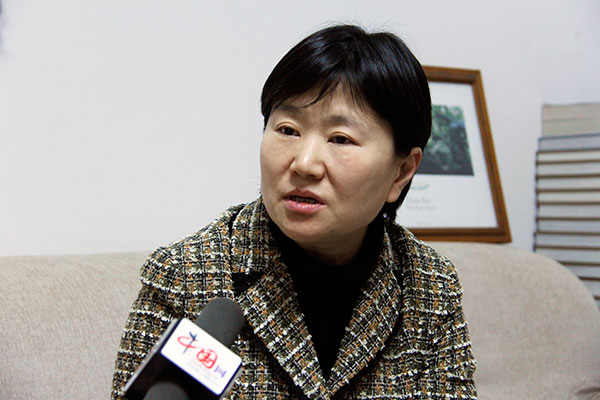 |
|
Lu Qiong accepts the exclusive interview of CIIC.[Photo/China.org.cn] |
The Key Tasks for State Administration of Cultural Heritage in 2017 has recently been released on the official website of State Administration of Cultural Heritage. It elaborates on the 32 steering instructions and specific measures to be exercised for strengthening the protection of cultural relics, promoting popular accessibility to the results of heritage protection and exploring approaches to the protective utilization of cultural relics in six areas for the year 2017. Among them, “enlivening cultural relics” is particularly eye-catching to the present reporter.
Promoting popularization of Chinese civilization by joint efforts of “Big Vs” via “Internet+”
Back in 2015, official accounts of museums including “Palace Museum,” “Shaanxi History Museum” and “Sichuan Guanghan Sanxingdui Museum” appeared in social media circles one after another. Those official accounts quickly rose to fame. “China Cultural Heritage,” the official microblog account of the State Administration of Cultural Heritage, went so far as to win the prize of “2016 Top 10 Influential Topics of Government Affairs Microblogs.”
During the holiday season for primary and secondary school students in the summer of 2016, “China Cultural Heritage” organized a romantic event—Appointment with Museums. The event was enthusiastically disseminated, attracting a readership of nearly 700 million, a figure demonstrating the strong social influence of museums as an important front for the construction of the public cultural service system.
“We are justified in being culturally self-confident, since we have such a broad mass base. Enhancing cultural self-confidence should be rooted in the soil of excellent traditional Chinese culture,” said Lu Qiong, deputy director of the Department of Policies and Laws, State Administration of Heritage. It proved that “Appointment with the Museum” was a successful action.
Probably because of the favorable results of Internet dissemination, the State Administration of Cultural Heritage, the National Development and Reform Commission, the Ministry of Science and Technology, the Ministry of Industry and Information Technology and the Ministry of Finance jointly issued at the end of 2016, The Three-Year Action Plan for “Internet+ Chinese Civilization,” turning the down-to-earth Internet dissemination into a macroscopic steering opinion.
According to the Action Plan, the Internet will be drawn on to seek alternative approaches for the inheritance, innovation and development of traditional Chinese culture and for exploration and expansion of the unique historical and artistic significances of cultural relics – enabling them to tell their own stories.
In fact, the concept of “enlivening cultural relics” has been put to practice in more fronts including the “Internet+.” Development of creative products is another “tonic” for giving life to cultural relics and bringing them closer to the people.
In the past year, the State Administration of Cultural Heritage selected 92 museums as pilot units for developing a series of eye-catching products. Lu Qiong told reporters that at Dunhuang International Cultural Expo in September 2016, a scarf printed with Dunhuang fresco instantly became popular among visitors, many of whom were full of praise for the elegant item capable of telling its own story.
Making cultural relics tell their own stories by staging exhibitions in Hong Kong and New York
As the relationship between the preservation of cultural relics and the promotion of social and economic development becomes closer, the cultural relics of China are keen to tell their stories not only to the people of the Chinese mainland.
To celebrate the 20th anniversary of the return of Hong Kong SAR to China and to support the “Asia Cultural Co-operation Forum” to be held in Hong Kong SAR in late November 2017, the State Administration of Cultural Heritage will hold an exhibition of Silk Road Heritage at the Hong Kong Museum of History, in collaboration with the Leisure and Cultural Services Department (LCSD) of Hong Kong SAR.
Focusing on “Silk Roads: the Routes Network of Chang’an–Tianshan Corridor,” is a program inscribed in the World Heritage list. Thanks to the joint efforts of China, Kazakhstan and Kyrgyzstan, the exhibition will draw on existing research and exhibitions and will be the first of its kind after the successful inscription of the program. It is expected to offer a sumptuous cultural feast for Hong Kong people.
In addition, to commemorate the 45th anniversary of the normalization of Sino–US relations, 31 heritage collection units from 13 provinces (cities) will display 283 pieces of cultural relics witnessing “the civilization of the Qin and Han dynasties” in 164 sets at the Metropolitan Museum of Art, New York, starting late March, 2017.
It is said that the exhibition will retell the stories of the classic period of Chinese civilization in the Qin and Han dynasties, exploring the formation of “Chinese culture” while focusing on the Silk Road connecting ancient China to the West and the Maritime Silk Road spanning South and Southeast Asia. It is expected to inspire scholars from home and abroad and deepen the knowledge of China by the Western public.
“Heritage work means protection, conservation and inheritance of public valuable resources. It is everyone’s obligation. Common support from all walks of life is needed to make it a success.” Lu Qiong told the reporter.
Follow this news feed: East Asia





